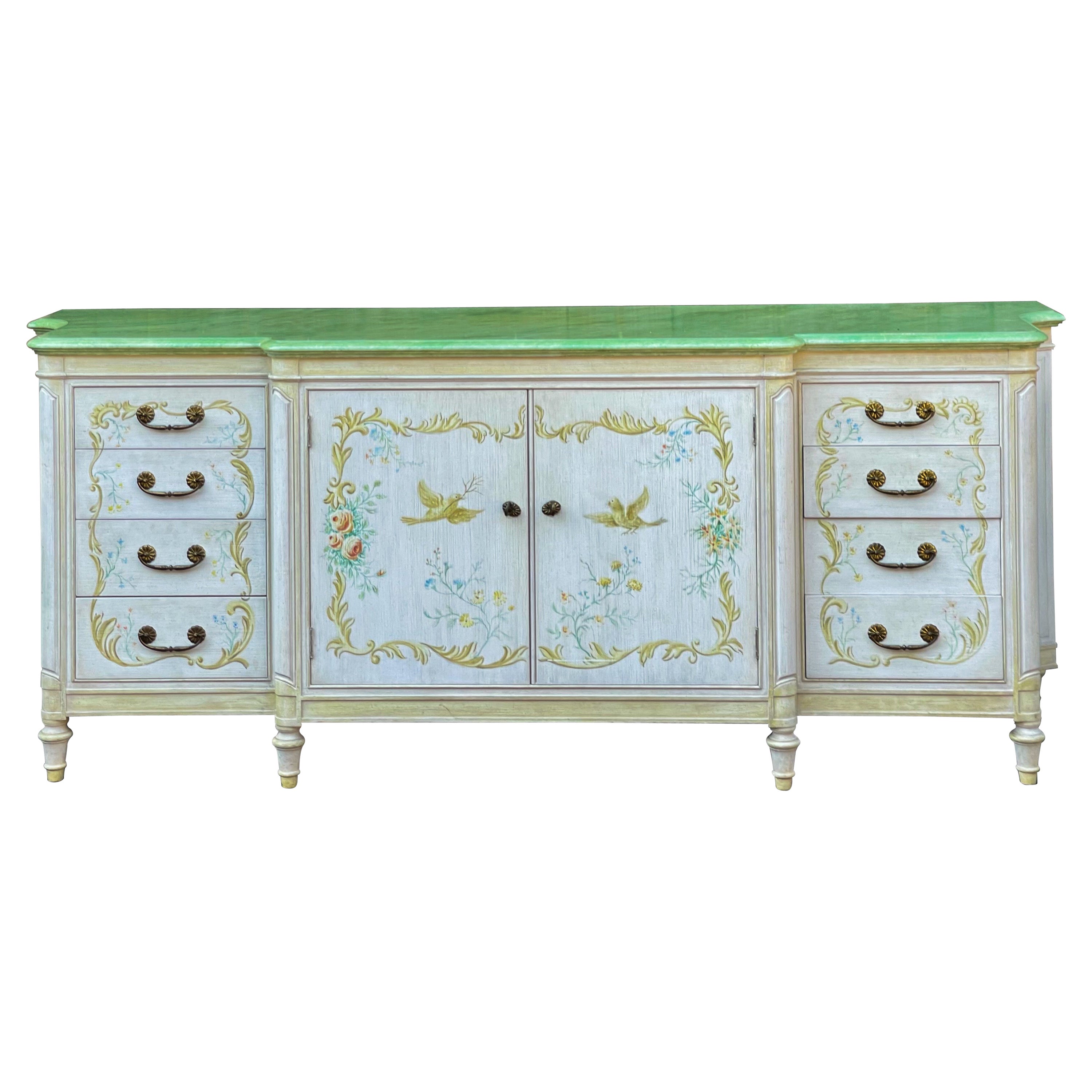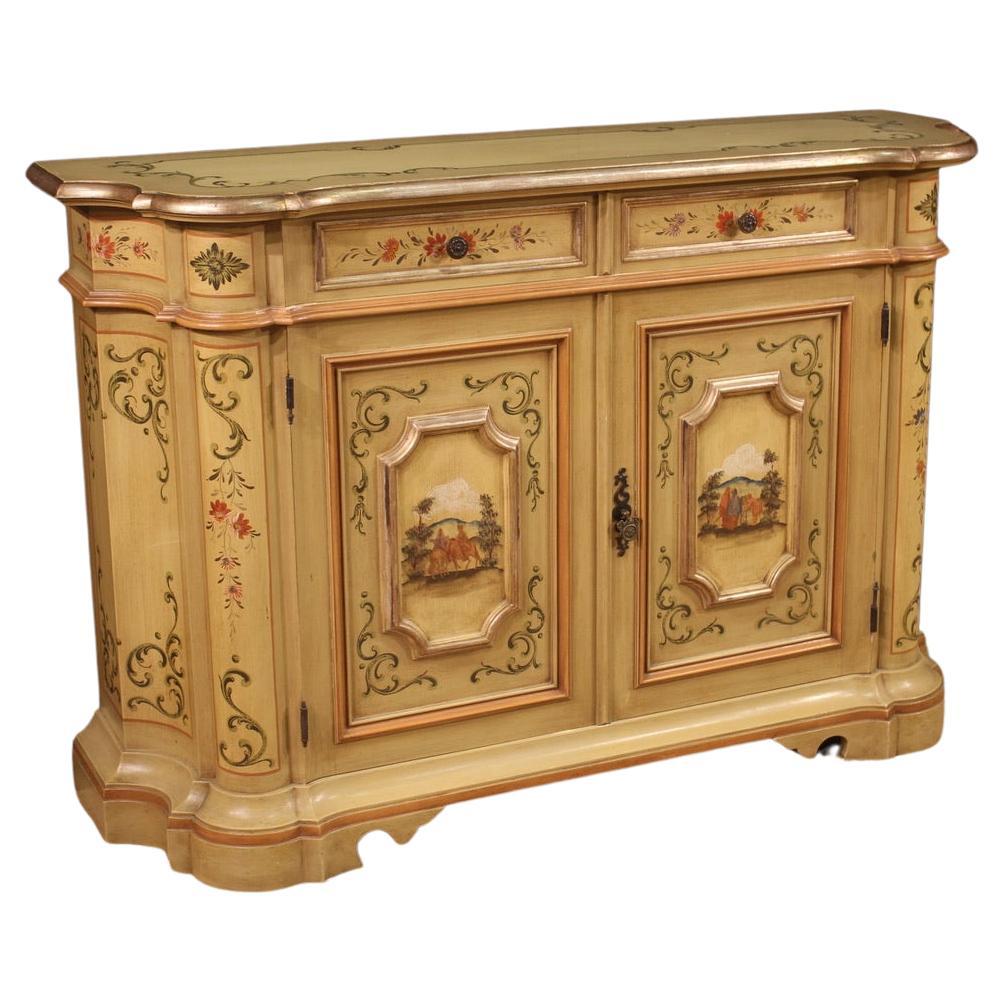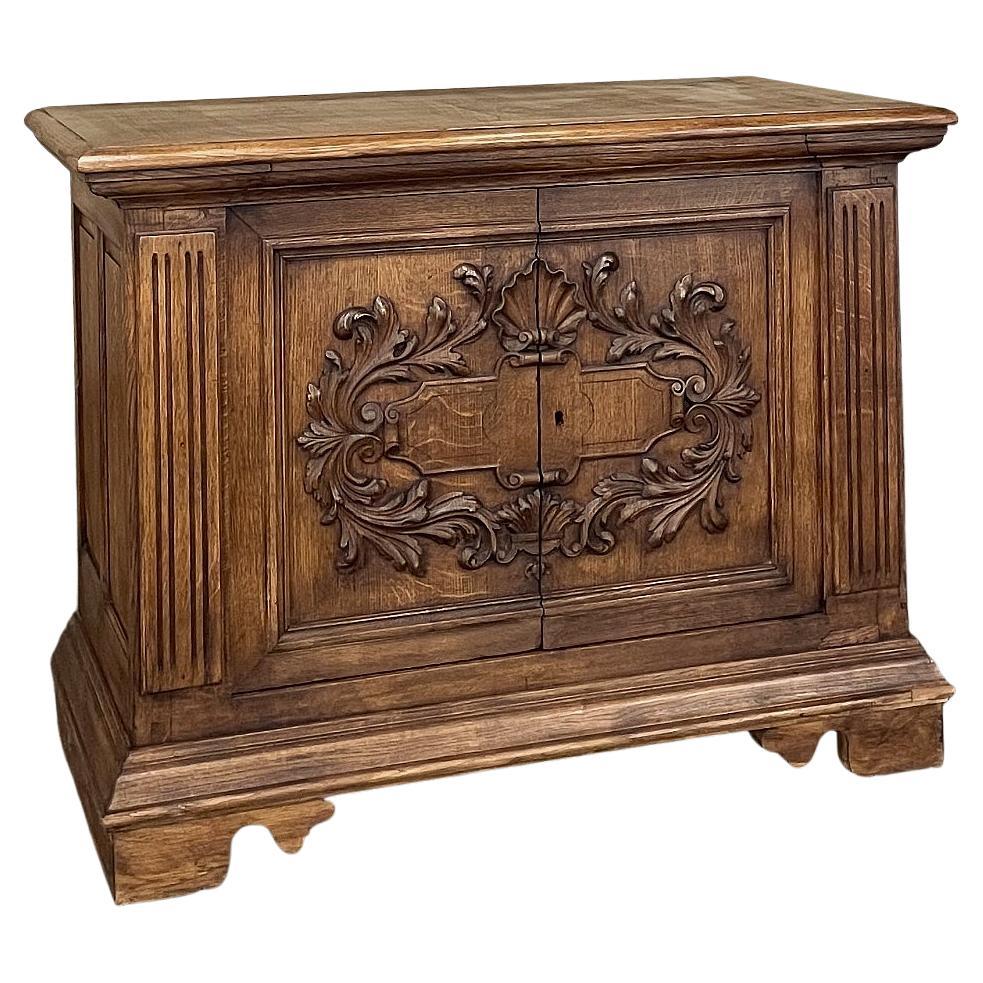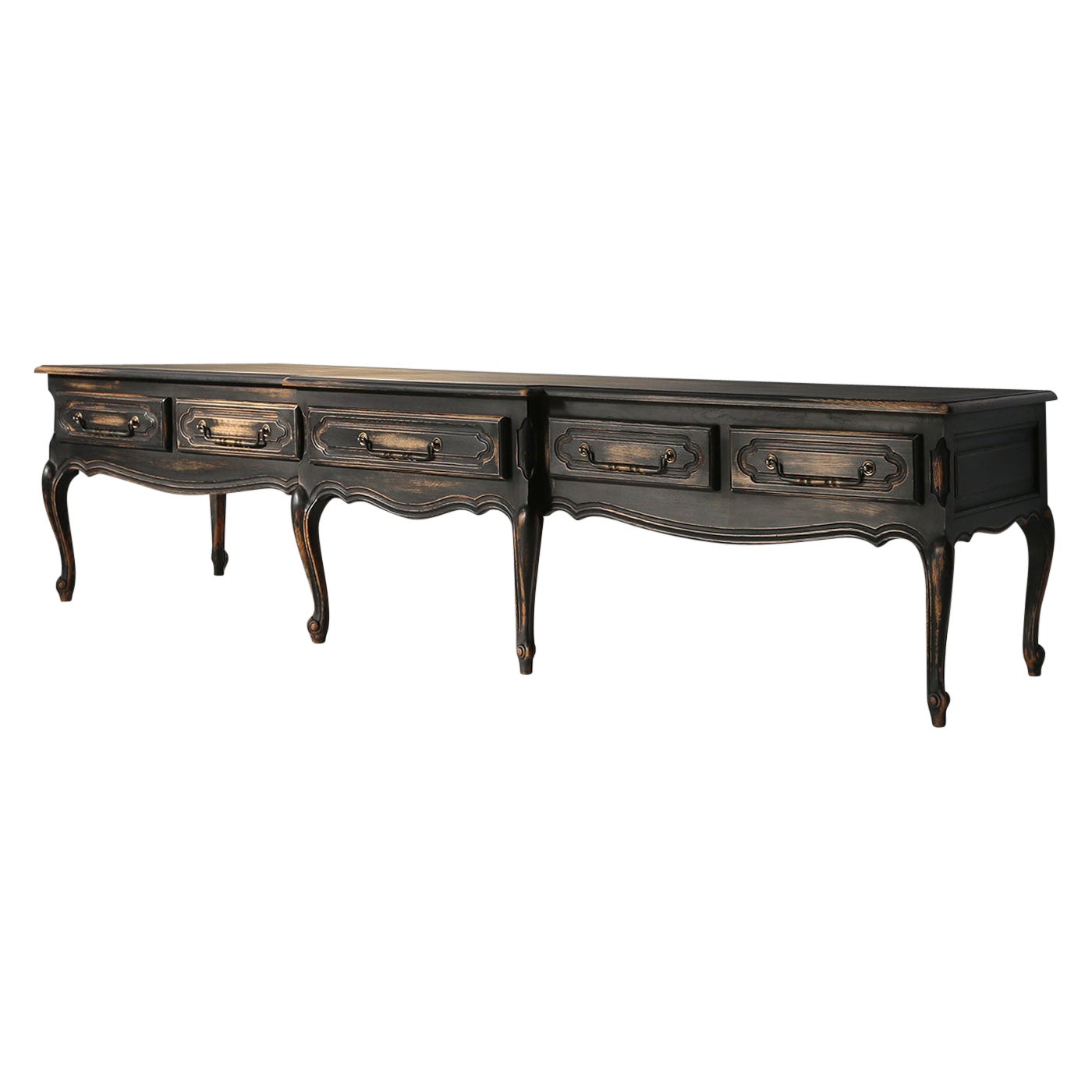Items Similar to Louis XIV Style Italian Venetian Lacquered Sideboard
Want more images or videos?
Request additional images or videos from the seller
1 of 21
Louis XIV Style Italian Venetian Lacquered Sideboard
About the Item
We kindly suggest that you read the entire description, as with it we try to give you detailed technical and historical information to guarantee the authenticity of our objects. The following item will be shipped via a courier specialized in shipping works of art, who, given the importance of the object, will arrange for it to be viewed at the Office of Fine Arts in Florence, so the piece of furniture will be even more enhanced by the Certificate of the prestigious office in Florence.
Important and rare lacquered and painted Venetian sideboard; the cabinet has a wavy and elegantly notched trapezoidal shape, and has two large doors that when opened reveal a large interior space divided by a vertical partition and two horizontal planes; this division was made in successive epochs as was the entire interior lining for which a yellow fabric was used; the upper exterior has a top executed in a single piece shaped with soft and refined lines; the entire cabinet and the solid base follow the undulating profile of the top giving the sideboard lightness and delicacy; the exquisite original lacquering has soft and delicate colors; the refined and graceful floral decorations of the doors are also repeated in the concave side panels producing a wavy and extremely refined effect. The cabinet, made of softwood, probably spruce, is in first patina with the original ironwork of the period. It was made between 1695 and 1710 in an artisan carpentry workshop in Venice. In fact, lacquered furniture in the Veneto region was mainly produced in the lagoon city, which was an important center of production of this type of furniture during the Renaissance and Baroque periods. The workshops of Venetian craftsmen were famous for their mastery in creating high-quality lacquered furniture, such as cabinets, sideboards, desks, and tables. These pieces of furniture were often made on commission for nobles, aristocrats, and churches, and were used to embellish palaces and prestigious residences.
The late seventeenth century and the early eighteenth century are characterized by the opposition between the cold, opulent severity of 'late Mannerism and the more grandiose and stunning Baroque that was emerging. The furniture, though still firm in its tradition, feels the decline of the characters of sobriety and balance that had given Europe the measure of the Renaissance. The lines of furniture are sober and straight, but they tend gradually to soften. Characters of utility yield in the face of the increasingly important value of decoration. One of the most important features of Italian furniture in this period is the art of lacquering, known and practiced in the Far East by the Chinese and Japanese from the earliest ages; Europe began to take an interest in it only in the early 1600s. European lacquers imitated by imported ones are composed of various essences, mixed resins, and various oils. In fact, whether in France, Italy, or England, lacquers are never as hard as those from the East. This diversity consists mainly of the preparation with chalk and glue. In Italy, the wood preferred by lacquerers is cirrmolo, which has the characteristic of being light, and soft and lends itself meekly to all the stylistic adaptations of the period. The wood was left well seasoned and cut into solid curved strips that overlapped to create the stem of the piece of furniture, destined later to be sent to the lacquerer for decoration. Surfaces to be decorated where any openings and cracks had occurred, due to temperature changes or for other reasons, were covered with a strip of glued canvas. The stem of the piece of furniture was later re-plastered all over with a layer of glue so that the wood could absorb it, closing its pores; then several layers of plaster and glue were given until a homogeneous surface was achieved, which was smoothed with very fine glass paper. This is the preparation technique for Venetian furniture, which has a very thick covering of plaster and glue compared to a couple of layers of lacquered furniture from Genoa, Piedmont, and other Italian regions. Once the plaster preparation was finished, a layer of primer or color was given with tempera, after which the decoration itself was done. Once this and the gilding were finished, several layers of sandracco varnish, i.e., a rubbery complement to the varnish, were passed, which with its characteristic straw color chromatically modified the lacquering. Depending on the layers of this varnish, it was possible to obtain a warm, transparent tone: for example, a particular yellow was obtained by passing sandracca over a white background, and the classic greenish was the result of one or more layers, depending on the desired effect, over a light blue background. Lacquered furniture was a privilege of the wealthy classes, and in Venice, the great painters of the time (Guardi, Tiepolo, Zuccarelli, and Zais ) received commissions to decorate apartments and consequently create cartoons for lacquering furniture. These pieces of furniture were highly valued for their beauty and were used as valuable pieces of furniture in aristocratic residences of the time. Today, Italian Venetian lacquered sideboards from the 1700s are considered true works of art and can be found in private collections, museums, and art galleries. Measurements length cm.189, depth cm.60, height cm.100.The sideboard is in good original condition and has not undergone major restoration, only retouching or minor repairs inside for 333 years.
- Dimensions:Height: 39.38 in (100 cm)Width: 74.41 in (189 cm)Depth: 23.63 in (60 cm)
- Style:Louis XIV (Of the Period)
- Materials and Techniques:
- Place of Origin:
- Period:Late 17th Century
- Date of Manufacture:1695-1710
- Condition:Wear consistent with age and use. The sideboard is in good original condition and has not undergone major restoration, only retouching or minor repairs inside for 333 years.
- Seller Location:Prato, IT
- Reference Number:
About the Seller
5.0
Platinum Seller
These expertly vetted sellers are 1stDibs' most experienced sellers and are rated highest by our customers.
Established in 1977
1stDibs seller since 2019
234 sales on 1stDibs
Typical response time: 2 hours
- ShippingRetrieving quote...Ships From: PRATO, Italy
- Return PolicyA return for this item may be initiated within 14 days of delivery.
More From This SellerView All
- Biedermeier Style Small Italian SideboardLocated in Prato, TuscanyWe kindly suggest that you read the whole description, as with it we try to give you detailed technical and historical information to guarantee the authenticity of our objects. Exce...Category
Antique Late 19th Century Italian Biedermeier Sideboards
MaterialsSapele Wood
- Louis XV Style French Wood Console Table with White Matte Lacquer FinishLocated in Prato, TuscanyWe kindly suggest you read the whole description, because with it we try to give you detailed technical and historical information to guarantee the authenticity of our objects. Pecul...Category
Antique Mid-18th Century French Louis XV Console Tables
MaterialsWood
- Louis Philippe Style Feather Walnut Coffee Table With Tripod North ItalyLocated in Prato, TuscanyWe kindly suggest you read the whole description, because with it we try to give you detailed technical and historical information to guarantee the authenticity of our objects. Elegant round coffee table from northern Italy with "orange slice" veneered with walnut-feather; the central stem of the tripod is in hexagonal solid wood; the three final supports, always in solid wood, are shaped and well whittled with simple and rigorous lines; at the center of the table, there is a delicate and refined inlay reproducing a rose, made by hand with soft precious woods, the two peripheral circles of the top are always inlaid. The most interesting and compelling feature of this table is the workmanship with which it was made: the " wood veneer"( Attention. The exact term is Italian "lastronatura" untranslatable in English, in fact, the "lastronatura" is very different and older than “wood veneer”. Read explanation later). The”lastronatura” is an artisan technique that spread already during the sixteenth century and remained unchanged until the mid-nineteenth century before the Industrial Revolution; it consisted of hand-cutting the trunks of noble wood (walnut, mahogany, briar, walnut-feather, etc.) with ancient saws in so many layers with thicknesses ranging from 4 to 6 millimeters, which were then applied to furniture for decorative purposes; the finishing of this procedure was very complex: the wood layer was treated with natural earth dissolved in water for the desired shade, it was aged with stone, fixed with shellac applied with a brush and finally polishing was performed in 12 steps...Category
Antique Mid-19th Century Italian Louis Philippe Coffee and Cocktail Tables
MaterialsWalnut
- Louis XVI Style Six Blown Italian Water Goblets with Gold RimLocated in Prato, TuscanyWe kindly suggest that you read the entire description, as with it we try to give you detailed technical and historical information to guarantee the authenticity of our objects. Refined and precious Italian blown glass water goblets; the set consists of six pieces; the bowl of each glass was barrel-blown, then the craftsman manually hot-attached the stem and base; once cooled, the glass was ground on both the bowl and stem; a fine pure gold rocaille process was then applied to the rim using...Category
Late 20th Century Italian Louis XVI Glass
MaterialsBlown Glass
- Louis Philippe Style Pair Of Chairs With Italian Armrests Model KingLocated in Prato, TuscanyFascinating and rare pair of Italian chairs with armrests model "King" or "Antique Master"; they are made of the best quality walnut; the comfortable backrest has an elaborate and re...Category
Antique Late 19th Century Italian Louis Philippe Chairs
MaterialsLinen, Walnut
- Louis XVI Style Six Blown and Colored Italian Wine Goblets Gold RimLocated in Prato, TuscanyWe kindly suggest that you read the entire description, as with it we try to give you detailed technical and historical information to guarantee the authenticity of our objects. Refined and precious Italian wine goblets made of blown glass; the set consists of six pieces; the bowl of each glass was barrel-blown, then the artisan manually attached the stem and base to it by heat; when the glass reached a low temperature, the master glassmaker spread a gold chloride pigment mixed with copper on the surface of the glass to achieve the soft red coloring; while the glass was still at a low temperature, a fine gold rocaille pattern was applied to the rim using...Category
Late 20th Century Italian Louis XVI Glass
MaterialsBlown Glass
You May Also Like
- 1960s Venetian Style Italian Sideboard / Credenza Or Cabinet W/ Faux Marble TopLocated in Kennesaw, GAThis is a large scale Venetian style hand painted cabinet with faux marble top. A versatile piece! It could work from sideboard to bath to foyer to changing table! It is unmarked and...Category
Mid-20th Century Italian Hollywood Regency Sideboards
MaterialsWood
- 20th Century Lacquered and Painted Wood Venetian Sideboard, 1960Located in Vicoforte, PiedmontVenetian sideboard from the second half of the 20th century. Finely sculpted, lacquered, silvered and hand painted furniture with animated views and floral decorations. Sideboard of ...Category
Vintage 1960s Italian Credenzas
MaterialsWood
- Antique French Louis XIV Petit Buffet, ConfiturierLocated in Dallas, TXAntique French Louis XIV petit buffet ~ confiturier is the perfect size for a special niche, between two windows, or especially as a truly unique sink vani...Category
Early 20th Century French Louis XIV Cabinets
MaterialsOak
- Sideboard in Louis- XIV styleLocated in Meulebeke, BEThis Louis XIV-style sideboard is a unique and stylish piece of furniture that takes any interior to the next level. It is inspired by the French king who was known for his luxurious...Category
Vintage 1950s Belgian Louis XIV Sideboards
MaterialsWood
- Sideboard in Louis XIV-styleLocated in Meulebeke, BEThis Louis XIV-style sideboard is a unique and stylish piece of furniture that takes any interior to the next level. It is inspired by the French king who was known for his luxurious...Category
Vintage 1950s Belgian Louis XIV Sideboards
MaterialsWood
- Postmodern 1980s Memphis Lacquered Sideboard Italian Vintage Italian CabinetBy Ettore SottsassLocated in London, GBThis sideboard, coloured duck egg blue and composed of lacquered wood, originated in Greece in the 1980s –– a time of great prosperity for the country, but imported from Italy in the...Category
Vintage 1980s Italian Post-Modern Sideboards
MaterialsMetal
Recently Viewed
View AllMore Ways To Browse
Drexel Stereo
Halabala 221
Halabala H 221
Hornslet Mobelfrabrik
Jim Zivic
Karl Springer Bubble Dresser
Mario Marenco 1978
Martin Hall On Sale
Primitive 220 Resin Credenza
Rima Credenza Beechwood
Stanley Teak
Teak Dining Table M U
Multicolored Credenza
George Nelson Thin Edge Credenza
Nelson Thin Edge Credenza
Grossman 62
Hp Hansen Credenza
Paul Evans Patchwork Burl Credenza





